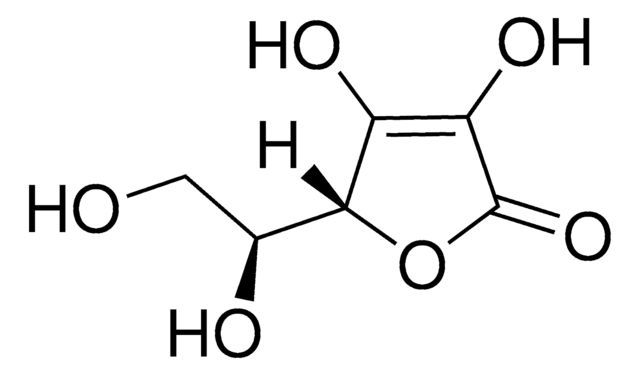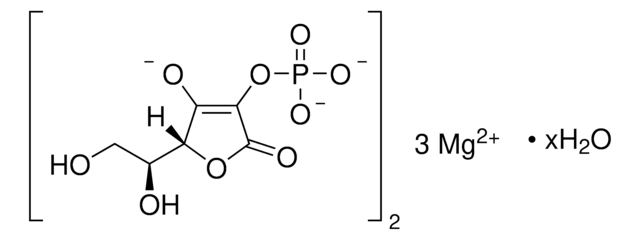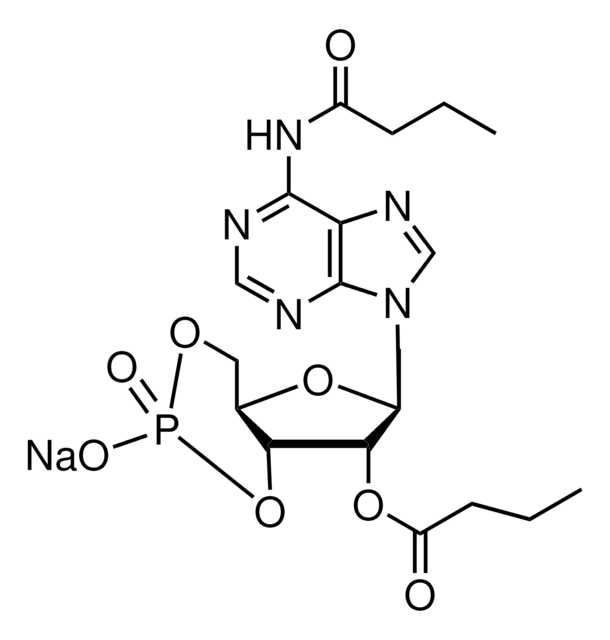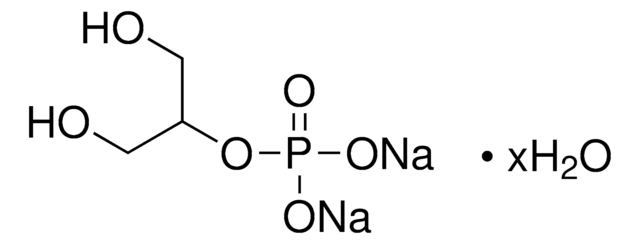A4403
L-Ascorbic acid
powder, suitable for cell culture, γ-irradiated
Recommended Products
biological source
synthetic (organic)
Quality Level
sterility
γ-irradiated
form
powder
mol wt
Mw 176.12 g/mol
technique(s)
cell culture | insect: suitable
cell culture | mammalian: suitable
cell culture | plant: suitable
color
white to off-white
pH
1.0-2.5 (25 °C, 176 g/L in water)
mp
190-194 °C (dec.)
solubility
H2O: 10 mg/mL
SMILES string
OC([C@]([C@@H](O)CO)([H])O1)=C(O)C1=O
InChI
1S/C6H8O6/c7-1-2(8)5-3(9)4(10)6(11)12-5/h2,5,7-10H,1H2/t2-,5+/m0/s1
InChI key
CIWBSHSKHKDKBQ-JLAZNSOCSA-N
Gene Information
human ... SLC23A2(9962)
Looking for similar products? Visit Product Comparison Guide
Related Categories
General description
Application
L-ascorbic acid has been used:
- in an osteogenic supplement for the growth of cells
- as a component in the differentiation media
- in WS-MSCs (Werner syndrome-mesenchymal stem cells) to study rescuing properties of ascorbic acid on aging defects
Biochem/physiol Actions
recommended
Storage Class Code
11 - Combustible Solids
WGK
WGK 3
Personal Protective Equipment
Certificates of Analysis (COA)
Search for Certificates of Analysis (COA) by entering the products Lot/Batch Number. Lot and Batch Numbers can be found on a product’s label following the words ‘Lot’ or ‘Batch’.
Already Own This Product?
Documents related to the products that you have purchased in the past have been gathered in the Document Library for your convenience.
Difficulty Finding Your Product Or Lot/Batch Number?
How to Find the Product Number
Product numbers are combined with Pack Sizes/Quantity when displayed on the website (example: T1503-25G). Please make sure you enter ONLY the product number in the Product Number field (example: T1503).
Example:
Additional examples:
705578-5MG-PW
PL860-CGA/SHF-1EA
MMYOMAG-74K-13
1000309185
enter as 1.000309185)
Having trouble? Feel free to contact Technical Service for assistance.
How to Find a Lot/Batch Number for COA
Lot and Batch Numbers can be found on a product's label following the words 'Lot' or 'Batch'.
Aldrich Products
For a lot number such as TO09019TO, enter it as 09019TO (without the first two letters 'TO').
For a lot number with a filling-code such as 05427ES-021, enter it as 05427ES (without the filling-code '-021').
For a lot number with a filling-code such as STBB0728K9, enter it as STBB0728 without the filling-code 'K9'.
Not Finding What You Are Looking For?
In some cases, a COA may not be available online. If your search was unable to find the COA you can request one.
Articles
Importance and uses of ascorbate in serum-free eukaryotic, including hybridoma and Chinese Hamster Ovary (CHO) cell, cultures
Naive pluripotent stem cells are located within the epiblast of mature blastocysts. These primitive “ground-state” cells may be cultured in vitro using specialized media and small molecule inhibitors.
rganoid culture products to generate tissue and stem cell derived 3D brain, intestinal, gut, lung and cancer tumor organoid models.
Protocols
Stem cell reprogramming protocols to generate human induced pluripotent stem cells (iPSCs) including viral and non-viral RNA based methods.
Our team of scientists has experience in all areas of research including Life Science, Material Science, Chemical Synthesis, Chromatography, Analytical and many others.
Contact Technical Service



